- Clone
- 6A6 (See other available formats)
- Regulatory Status
- RUO
- Other Names
- BTLA, B and T lymphocyte attenuator
- Isotype
- Armenian Hamster IgG
- Barcode Sequence
- TGACCCTATTGAGAA
| Cat # | Size | Price | Quantity Check Availability | ||
|---|---|---|---|---|---|
| 139113 | 10 µg | $369.00 | |||
CD272, also known as B and T lymphocyte attenuator (BTLA), is an Ig superfamily co-inhitory receptor with structural similarity to programmed cell death 1 (PD-1) and CTLA-4. BTLA is expressed on B cells, T cells, macrophages, dendritic cells, NKT cells, and NK cells. Engagement of BTLA by its ligand herpes virus entry mediator (HVEM) is critical for negatively regulating immune response. The absence of BTLA with HVEM inhibitory interactions leads to increased experimental autoimmune encephalomyelitis severity, enhanced rejection of partially mismatched allografts, an increased CD8+ memory T cell population, increased severity of colitis, and reduced effectiveness of T regulatory cells. BTLA plays an important role in the induction of peripheral tolerance of both CD4+ and CD8+ T cells in vivo. Tolerant T cells have significantly higher expression of BTLA compared with effectors and naïve T cells. BTLA may cooperate with CTLA-4 and PD-1 to control T cell tolerance and autoimmunity. It was reported that BTLA may regulate T cell function by binding to B7-H4, but further studies are needed to confirm. The existence of three distinct BTLA alleles has been reported.
Product Details
- Verified Reactivity
- Mouse
- Antibody Type
- Monoclonal
- Host Species
- Armenian Hamster
- Immunogen
- C57BL/6 BTLA Ig domain protein in CFA
- Formulation
- Phosphate-buffered solution, pH 7.2, containing 0.09% sodium azide and EDTA
- Preparation
- The antibody was purified by chromatography and conjugated with TotalSeq™-A oligomer under optimal conditions.
- Concentration
- 0.5 mg/ml
- Storage & Handling
- The antibody solution should be stored undiluted between 2°C and 8°C. Do not freeze.
- Application
-
PG - Quality tested
- Recommended Usage
-
Each lot of this antibody is quality control tested by immunofluorescent staining with flow cytometric analysis and the oligomer sequence is confirmed by sequencing. TotalSeq™-A antibodies are compatible with 10x Genomics Single Cell Gene Expression Solutions.
To maximize performance, it is strongly recommended that the reagent be titrated for each application, and that you centrifuge the antibody dilution before adding to the cells at 14,000xg at 2 - 8°C for 10 minutes. Carefully pipette out the liquid avoiding the bottom of the tube and add to the cell suspension. For Proteogenomics analysis, the suggested starting amount of this reagent for titration is ≤ 1.0 µg per million cells in 100 µL volume. Refer to the corresponding TotalSeq™ protocol for specific staining instructions.
Buyer is solely responsible for determining whether Buyer has all intellectual property rights that are necessary for Buyer's intended uses of the BioLegend TotalSeq™ products. For example, for any technology platform Buyer uses with TotalSeq™, it is Buyer's sole responsibility to determine whether it has all necessary third party intellectual property rights to use that platform and TotalSeq™ with that platform. - Application Notes
-
Additional reported applications (for relevant formats) include: immunoprecipitation1,2 and blocking3,5 of OT-I T cell responses in vitro and incidence of cerebral malaria in vivo caused by P. berghei ANKA (PbA) infection. The LEAF™ purified antibody (Endotoxin < 0.1 EU/µg, Azide-Free, 0.2 µm filtered) is recommended for functional assays (Cat. No. 139104). For highly sensitive assays, we recommend Ultra-LEAF™ purified antibody (Cat. No. 139117 - 139122) with a lower endotoxin limit than standard LEAF™ purified antibodies (Endotoxin < 0.01 EU/µg).
Clone 6A6 antibody reacts only with the C57BL/6 allele of BTLA but not the BALB/c allele of BTLA. - Additional Product Notes
-
TotalSeq™ reagents are designed to profile protein levels at a single cell level following an optimized protocol similar to the CITE-seq workflow. A compatible single cell device (e.g. 10x Genomics Chromium System and Reagents) and sequencer (e.g. Illumina analyzers) are required. Please contact technical support for more information, or visit biolegend.com/totalseq.
The barcode flanking sequences are CCTTGGCACCCGAGAATTCCA (PCR handle), and BAAAAAAAAAAAAAAAAAAAAAAAAAAAAAA*A*A (capture sequence). B represents either C, G, or T, and * indicates a phosphorothioated bond, to prevent nuclease degradation.
View more applications data for this product in our Scientific Poster Library. -
Application References
(PubMed link indicates BioLegend citation) -
- Hurchla MA, et al. 2005. J. Immunol. 174:337. (IP FC)
- Sedy JR, et al. 2005. Nat. Immunol. 6:90. (IP)
- Lepenies B, et al. 2007. J. Immunol. 179:4093. (Block)
- Tao R, et al. 2005. J. Immunol. 175:5774. (FC)
- Albring J, et al. 2010. J. Exp. Med. 207:2551. (Block)
- Product Citations
-
- RRID
-
AB_2814041 (BioLegend Cat. No. 139113)
Antigen Details
- Structure
- An Ig superfamily co-inhibitory receptor with structural similarity to programmed cell death 1 (PD-1) and CTLA-4.
- Distribution
-
BTLA is expressed on a wide number of lymphocytes in mice. It is most highly expressed on B cells, followed by CD4+ T cells, lower expression on CD8+ T cells, macrophages, dendritic cells, NKT cells, and NK cells.
- Function
- BTLA functions as a negative regulator of T cell activation and proliferation, attenuate B cell proliferation upon associating with its known ligand, herpes virus entry mediator (HVEM).
- Ligand/Receptor
- HVEM.
- Cell Type
- B cells, Dendritic cells, Lymphocytes, NKT cells, T cells
- Biology Area
- Immunology, Inhibitory Molecules
- Molecular Family
- CD Molecules
- Antigen References
-
1. Liu X, et al. 2009. J Immunol. 182:4516.
2. Miller ML, et al. 2009. J Immunol. 183:32.
3. Sun Y, et al. 2009. J Immunol. 183:1946.
4. Vendel AC, et al. 2009. J Immunol. 182:1509.
5. Watanabe N, et al. 2003. Nat Immunol. 4:670. - Gene ID
- 208154 View all products for this Gene ID
- UniProt
- View information about CD272 on UniProt.org
Other Formats
View All CD272 Reagents Request Custom Conjugation| Description | Clone | Applications |
|---|---|---|
| Alexa Fluor® 647 anti-mouse CD272 (BTLA) | 6A6 | FC |
| PE anti-mouse CD272 (BTLA) | 6A6 | FC |
| APC anti-mouse CD272 (BTLA) | 6A6 | FC |
| TotalSeq™-A0881 anti-mouse CD272 (BTLA) | 6A6 | PG |
| PE/Cyanine7 anti-mouse CD272 (BTLA) | 6A6 | FC |
| Ultra-LEAF™ Purified anti-mouse CD272 (BTLA) | 6A6 | FC,IP |
| TotalSeq™-C0881 anti-mouse CD272 (BTLA) | 6A6 | PG |
| PE/Fire™ 640 anti-mouse CD272 (BTLA) | 6A6 | FC |
| PE/Fire™ 700 anti-mouse CD272 (BTLA) | 6A6 | FC |
| TotalSeq™-B0881 anti-mouse CD272 (BTLA) | 6A6 | PG |
Compare Data Across All Formats
This data display is provided for general comparisons between formats.
Your actual data may vary due to variations in samples, target cells, instruments and their settings, staining conditions, and other factors.
If you need assistance with selecting the best format contact our expert technical support team.
-
Alexa Fluor® 647 anti-mouse CD272 (BTLA)
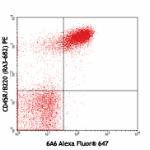
C57BL/6 splenocytes stained with CD45R/B220 (RA3-6B2) PE and... -
PE anti-mouse CD272 (BTLA)
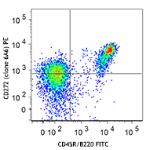
C57BL/6 mouse splenocytes were stained with CD45R/B220 FITC ... 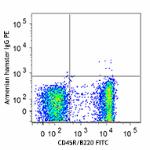
-
APC anti-mouse CD272 (BTLA)
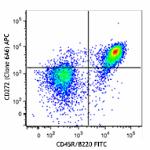
C57BL/6 mouse splenocytes were stained with CD45R/B220 FITC ... 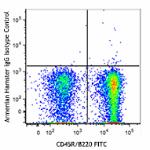
-
TotalSeq™-A0881 anti-mouse CD272 (BTLA)
-
PE/Cyanine7 anti-mouse CD272 (BTLA)

C57BL/6 mouse splenocytes were stained with CD45R/B220 FITC ... -
Ultra-LEAF™ Purified anti-mouse CD272 (BTLA)
-
TotalSeq™-C0881 anti-mouse CD272 (BTLA)
-
PE/Fire™ 640 anti-mouse CD272 (BTLA)

C57BL/6 mouse splenocytes were stained with anti-mouse CD45R... -
PE/Fire™ 700 anti-mouse CD272 (BTLA)

C57BL/6 mouse splenocytes were stained with anti-mouse/human... -
TotalSeq™-B0881 anti-mouse CD272 (BTLA)
